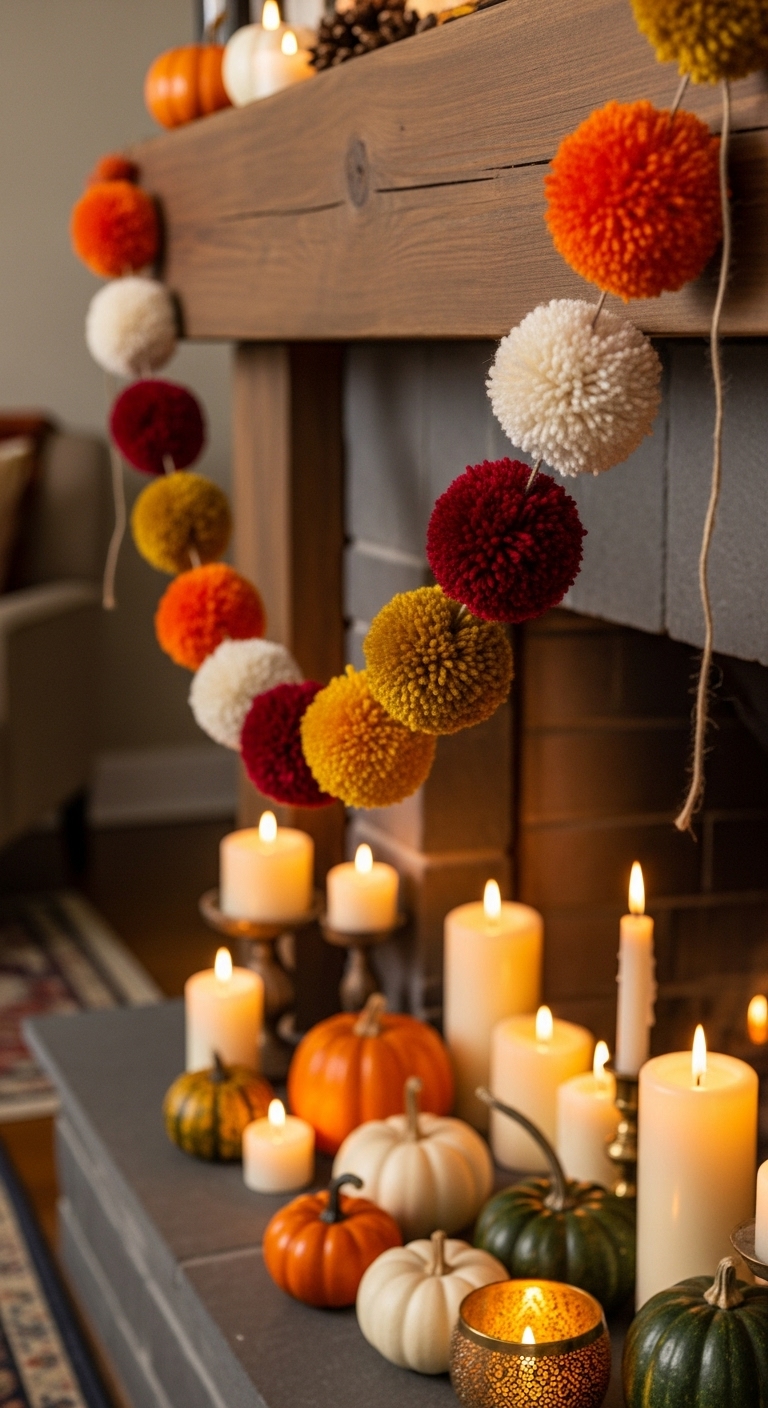
Key Takeaways
- Decorating with garland ideas doesn’t require plastic — natural materials like oranges, rosemary, pinecones, and fabric scraps look just as festive.
- Store-bought glitter, ribbons, and faux florals often contain hidden plastics that shed microfibers or create non-compostable waste.
- Choosing biodegradable or reusable alternatives helps reduce plastic pollution while keeping your home cozy and welcoming for the holidays.
Thanksgiving is one of those holidays that’s all about the vibes—gathering with the people you love, sharing good food, and making your home feel warm and inviting. But let’s be honest: if you’ve ever walked through the seasonal aisle at a big-box store, you know how much of that décor is just plastic. Glittery faux leaves, synthetic garlands, oversized shiny pumpkins, it’s festive for a moment, but it all ends up as waste.
Decorating with garland ideas that skip the plastic altogether is a better choice. Think dried oranges, fresh rosemary, pinecones, fabric scraps, or even pressed leaves from your own backyard. These pieces feel authentic, cozy, and much more personal than anything you could find in a store. That’s why I’ve put together 10 simple DIY garland ideas to help you decorate for Thanksgiving in a way that’s festive, sustainable, and totally plastic-free.
Why Reducing Plastic Pollution Matters
Let’s get real, plastic pollution is more than just messy beaches and overflowing bins. Every year, we produce over 400 million tons of plastic, and most of it is designed for single use. Instead of breaking down, it shatters into tiny pieces called microplastics and nanoplastics. Scientists are now finding those fragments in soil, oceans, drinking water, and yes, even in our bodies.
Here’s where it gets personal: microplastics have shown up in human blood, lung tissue, and even placental tissue. While researchers are still determining the long-term effects, early evidence suggests that inflammation, hormone disruption, and chemical exposure may have a significant impact on health.
That’s why making simple swaps matters. When you decorate with garland ideas made from natural or reusable materials, you’re helping slow down the cycle of plastic waste. These garlands can be composted, reused, or returned safely to the earth—no landfill guilt required. It’s a slight shift that creates a home that’s beautiful, festive, and genuinely aligned with a more sustainable future.
Ditch the Plastic, Keep the Style
When you’re crafting, it’s tempting to grab whatever looks cute in the store, but not all supplies are created equal. Many everyday craft staples, such as glitter, synthetic ribbons, and plastic beads, are made from plastics that shed microfibers, create waste, and persist in the environment for centuries. There are easy, affordable, and way prettier alternatives that give you the same effect without the hidden plastic. Here’s your quick guide to smarter swaps.
| ❌ Skip This | ✅ Use That |
|---|---|
| Plastic glitter | Biodegradable glitter made from plant cellulose |
| Metallic spray paints | Natural metallic powders (mica, bronze, or clay paint) |
| Synthetic store-bought ribbons | Cotton, linen, or jute ribbon |
| Foam or plastic embellishments | Wood ornaments, dried gourds, or mini pumpkins |
| Chemical-heavy glues | Starch-based paste, wheat paste, or natural twine ties |
| Sequins & plastic beads | Wood, glass, clay, or dried seed beads |
| Synthetic faux florals | Fresh greenery, dried flowers, or paper florals |
| Conventional parchment paper | Unbleached compostable parchment or reusable silicone baking mats |
These swaps keep the same look and function but ensure your garlands are biodegradable, reusable, or compostable.
Why These Common Craft Items Count as Plastic
✨ Glitter
Most conventional glitter is made from tiny particles of PET (polyethylene terephthalate) or PVC (polyvinyl chloride) coated in aluminum. These microplastics never break down and easily wash into waterways.
🎨 Metallic Spray Paints
The “metallic” effect often comes from synthetic polymers mixed with pigments. Once sprayed, these polymers coat natural items in a plastic film, making them non-compostable.
🎀 Synthetic Ribbons
Store-bought ribbons are usually woven from polyester, nylon, or acrylic — all petroleum-based plastics. Over time they shed microfibers, which are a major source of microplastic pollution.
🎭 Foam or Plastic Embellishments
Craft foam and plastic decorations are made from expanded polystyrene (EPS), PVC, or other plastic resins. These break down into microplastics but never biodegrade.
🧴 Chemical-Heavy Glues
Hot glue sticks and many liquid craft glues are based on synthetic resins like EVA (ethylene-vinyl acetate) or PVA (polyvinyl acetate). These are plastic polymers, meaning once used, they add plastic to otherwise compostable projects.
💎 Sequins & Plastic Beads
Sequins are typically PVC or PET, and most inexpensive craft beads are acrylic or polystyrene plastic. Both are petroleum-based and persist in the environment indefinitely.
🌸 Synthetic Faux Florals
Artificial greenery and flowers are almost always made of polyester or PVC, often reinforced with wire. They look pretty but are entirely plastic-based.
📜 Conventional Parchment Paper
Most standard parchment paper is coated with silicone (a synthetic polymer) or quilon (a chemical treatment that contains chromium). Both coatings make it functionally plastic-like and non-compostable.
Don’t Miss: The Truth About Plastic Ready to take your sustainability journey beyond holiday décor? This article explains why reducing plastic is so important. Read more →10 Gourd-geous DIY Thanksgiving Garland Ideas
Garlands are one of the easiest ways to transform your home for the holidays. They instantly bring warmth, texture, and charm to a space — whether you hang them across the mantel, drape them over a dining table, or frame a doorway to welcome guests.
1. Corn Husk Garland — Harvest-Inspired
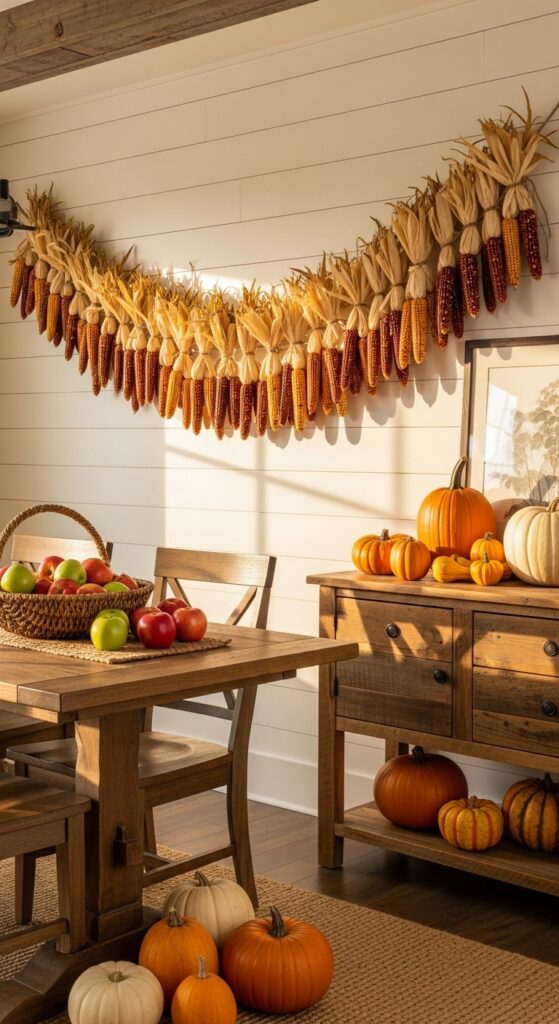
This garland feels straight out of a harvest festival. Corn husks are humble, natural, and surprisingly pretty when tied in bunches. It’s the perfect choice for a rustic Thanksgiving setup that celebrates the season’s roots.
What You Need:
- Dried corn husks
- Twine or raffia
- Scissors
How to Make It:
- Gather corn husks and trim to even sizes.
- Tie them into small bundles using twine.
- String the bundles together, spacing them evenly.
- Hang across a wall, porch, or mantel for a harvest-ready display.
2. Leaf Garland — Nature’s Own Decor

If you want the most budget-friendly, eco-friendly option, this is it. Autumn leaves already bring all the color and beauty you need, and pressing them means you get to enjoy them long after the season passes. It’s a classic for a reason.
What You Need:
- Colorful autumn leaves
- Heavy books or a flower press
- Twine
- Tape or mini clothespins
How to Make It:
- Collect leaves in different colors and sizes.
- Press them between book pages for several days until flat and dry.
- Attach leaves to twine using tape, glue dots, or clothespins.
- Hang in a window or across a wall for natural fall color.
3. Pinecone Garland — Rustic and Natural
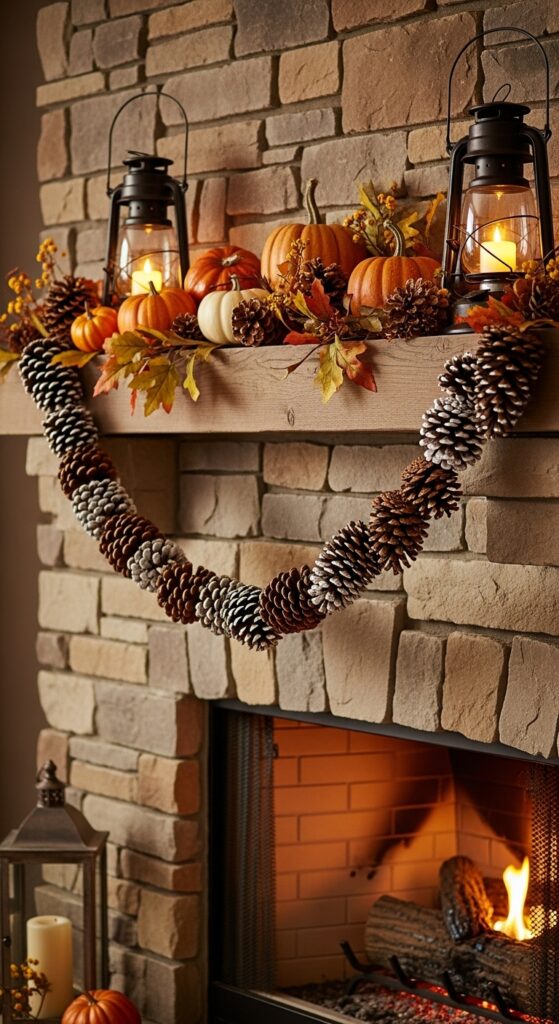
This garland feels like you went for a woodland walk and brought the best parts home. Pinecones add texture, warmth, and a natural, outdoorsy charm. Paint the tips if you want a frosted effect, or leave them as-is for pure rustic style.
What You Need:
- Pinecones
- Twine
- Hot glue gun
- Optional: paint or cinnamon oil
How to Make It:
- Collect or buy pinecones of similar size.
- Tie or hot glue twine around the base of each pinecone.
- Space them evenly along the length of the twine.
- Hang them up, and if you like, brush on paint or add a touch of scent.
4. Fabric Scrap Garland — Textured and Eclectic
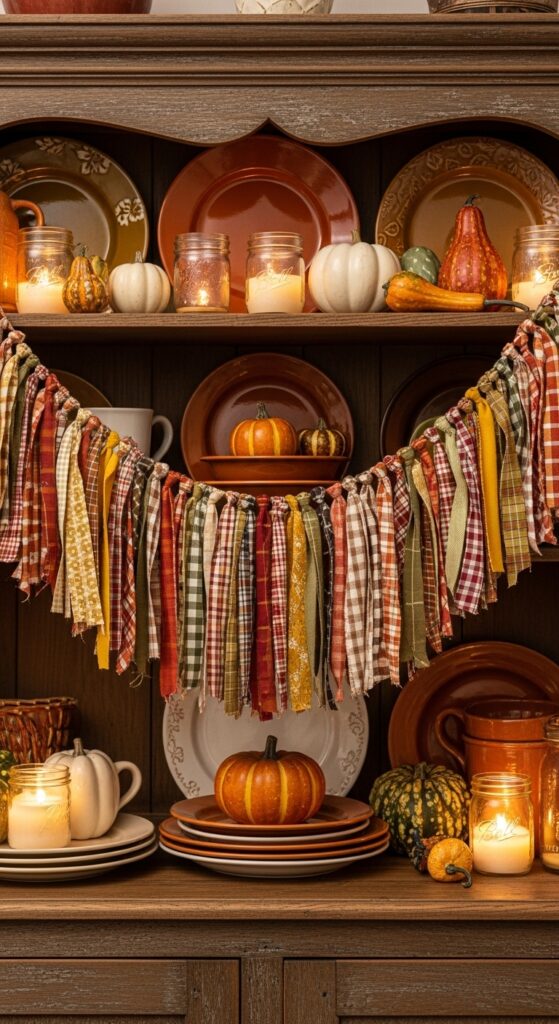
This garland is what happens when you combine resourcefulness with style. Grab those old fabric scraps, ribbon leftovers, or even cut-up T-shirts, and suddenly you’ve got a boho-chic garland that looks way more expensive than it is.
What You Need:
- Fabric scraps or ribbon
- Scissors
- Twine or rope
How to Make It:
- Cut your fabric into strips about an inch wide.
- Knot the strips onto a piece of twine, pushing them close together for fullness.
- Keep going until you like how it looks.
- Hang it across a headboard, wall, or mantel for instant Anthropologie vibes.
5. Paper Chain Garland — Nostalgic and Easy
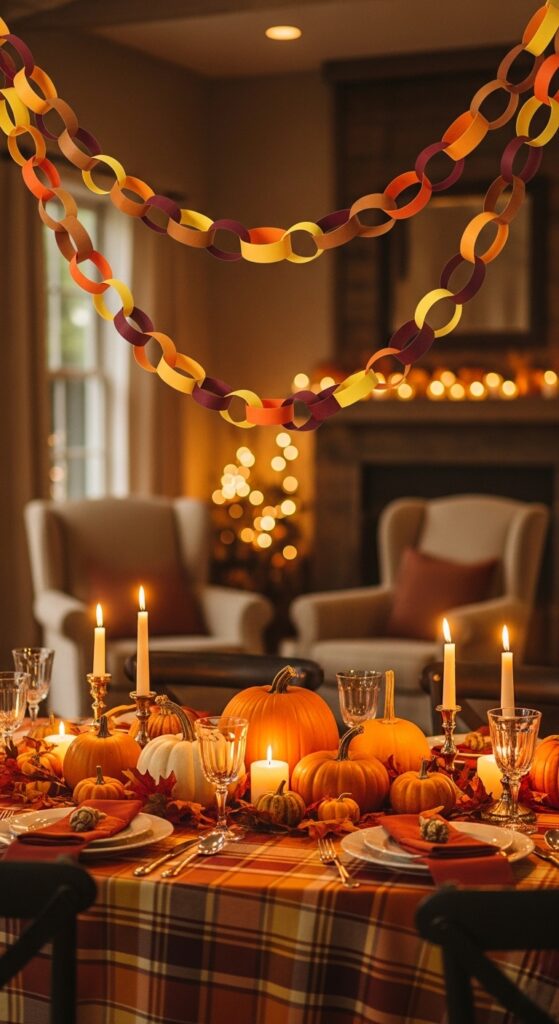
This is the throwback project that takes you straight back to grade school crafts. It’s simple, colorful, and weirdly satisfying to make.
Plus, you can adapt it to whatever look you’re going for—bold and bright, muted and minimal, or even metallic for something fancy.
What You Need:
- Colored or patterned paper
- Scissors
- Glue stick or tape
How to Make It:
- Cut paper into strips about an inch wide.
- Loop one strip into a circle and secure it closed with glue or tape.
- Slide the next strip through the loop and glue to make a chain.
- Keep going until it’s long enough to decorate your space.
✨tips
Styling Ideas
- Mix smooth elements, such as wooden beads, with rustic ones, like pinecones or fabric scraps, to create a unique texture. The contrast makes your garland look intentional and layered.
- Work in odd numbers when adding accents, such as dried oranges or mini pumpkins. Odd groupings look more natural and pleasing to the eye.
- If your garland feels too sparse, tuck in extra greenery or leftover fabric scraps. It fills the gaps without needing more store-bought supplies.
- Anchor your garland with sturdy twine or jute first, then build on top of it. Having a solid base makes it easier to layer and add decorative elements.
- Think beyond the mantel. Drape garlands on mirrors, windows, stair railings, or use them as a centerpiece runner to add more festive touches to your home.
6. Tassel Garland — Boho With a Twist
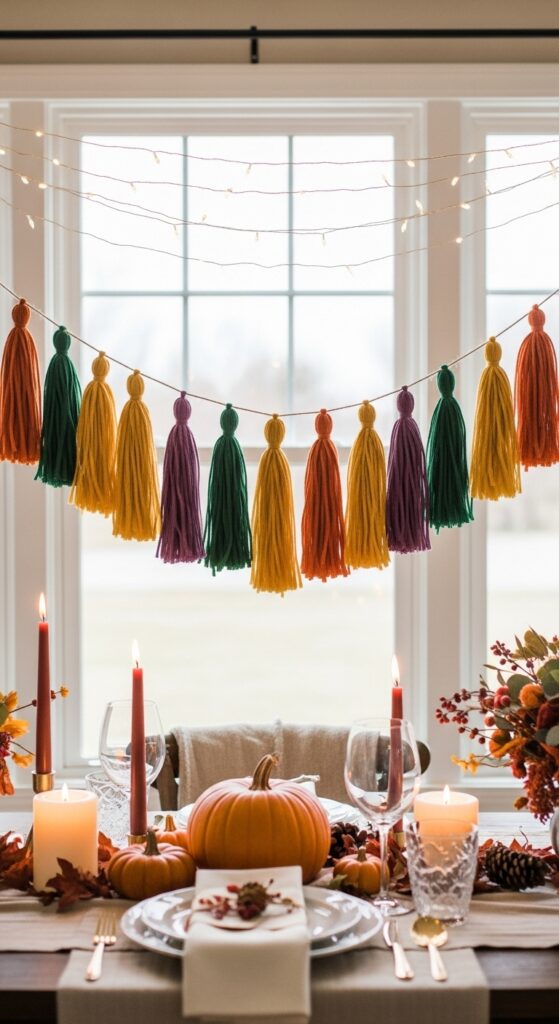
Tutorial by What’s Up Moms
If you love texture, this is your garland. Tassels bring that fringe-y, laid-back look that feels straight out of a boho apartment tour. Bonus: they’re easier to make than they look, and you can mix colors for a fun, eclectic vibe.
What You Need:
- Yarn or embroidery floss
- Scissors
- Twine
How to Make It:
- Wrap yarn around a piece of cardboard or a book about 20 times.
- Slide it off, tie tightly at the top, and cut the bottom loops.
- Trim into a neat tassel shape.
- Repeat until you have a bunch, then tie or slide them onto twine.
- Hang anywhere you want that casual, boho feel.
7. Beaded Garland — Minimalist but Stylish

Sometimes less really is more. A beaded garland is neutral, chic, and looks amazing no matter how you style it. Keep it natural for a Scandinavian vibe, or add painted beads to play with color. Either way, it’s one of those “how is this so simple but so good?” projects.
What You Need:
- Wooden beads in mixed sizes
- Twine or jute string
- Scissors
- Optional: paint for beads
How to Make It:
- Cut twine to your desired length.
- Thread the beads in any order—uniform or totally random both work.
- Knot the ends so the beads stay put.
- Hang it across a mantel, wrap it around a vase, or layer it with greenery.
8. Dried Orange Garland — Warm and Festive

This garland does double duty: it looks gorgeous and smells incredible. The slices glow like stained glass in the light, and the scent feels like you’ve been simmering mulled cider all day. Adding rosemary and cinnamon sticks gives it that extra holiday depth, like your kitchen turned into a cozy spice market. Hang it in the kitchen, on a window, or anywhere you want those cozy vibes.
What You Need:
- Oranges
- Sharp knife
- Baking sheet with parchment paper
- Twine
- A needle or skewer
- Fresh rosemary sprigs
- Cinnamon sticks
How to Make It:
- Slice the oranges thin and even so they dry out properly.
- Lay them on parchment and bake at 200°F for 2–3 hours until completely dried.
- Let the slices cool fully.
- Thread them onto twine with a needle or skewer, spacing them a couple of inches apart.
- Between some of the slices, tie on a sprig of rosemary and a cinnamon stick for added texture and scent.
9. Pom-Pom Garland — Playful and Cozy
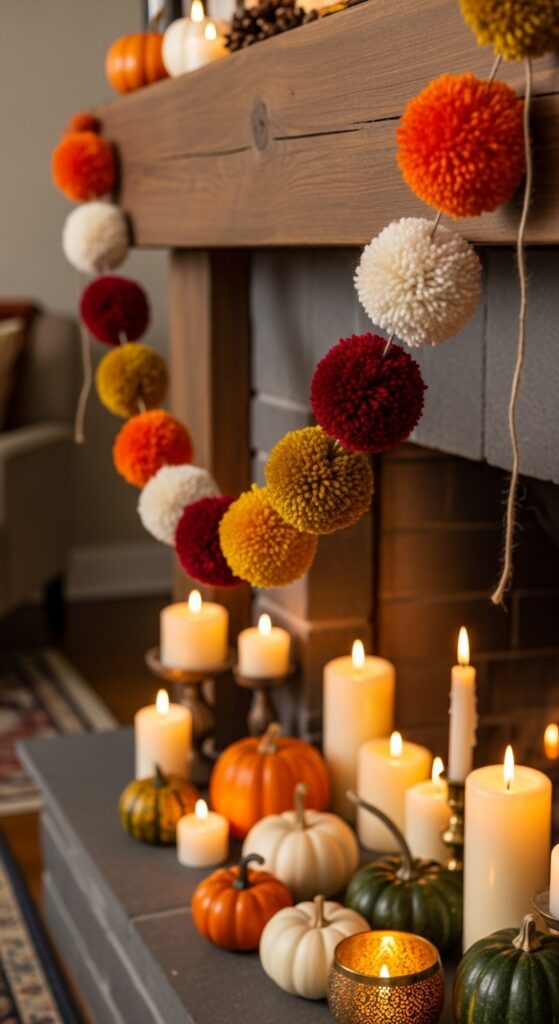
Tutorial by Sheep & Stitch
This garland is the definition of cozy charm. It’s handmade, colorful, and instantly softens a room. If you’re going for cottagecore, boho, or want something fun and whimsical, this is the piece that makes people smile the second they walk in.
What You Need:
- Yarn in your favorite colors
- A pom-pom maker (If you’re missing the gadget, this tutorial shows you how to do it by hand.)
- Scissors
- Twine or string
How to Make It:
- Wrap yarn around the pom-pom maker or fork until you have a thick bundle.
- Tie it tightly in the center.
- Cut the loops to release the pom-pom and trim to your desired fluffiness.
- Repeat this process until you have a collection, then string them onto twine and hang them.
10. Greenery Garland — Effortlessly Elegant

There’s just something about fresh greenery that feels instantly elevated. It smells fantastic, looks like it came from a high-end home magazine, and works in literally any room.
Whether you drape it over a mantel, run it down the dining table, or hang it on a doorway, this garland is your shortcut to that “I actually planned” holiday vibe.
What You Need:
- Fresh eucalyptus, magnolia, or pine
- Twine or floral wire
- Scissors or pruning shears
- Optional: fabric cut ribbons or dried flowers
How to Make It:
- Cut your greenery into smaller, workable stems.
- Lay stems so they overlap in one direction and secure them to twine with floral wire.
- Continue layering until your garland reaches the desired length.
- Hang or drape it where you need a touch of effortless style.
FAQs on Decorating with Garland Ideas
Natural garlands, such as dried oranges, pinecones, and fabric scraps, can last several weeks if kept indoors in a superb, dry location. Fresh greenery garlands usually stay vibrant for about 7–10 days before starting to dry out. To extend their life, lightly mist greenery and avoid placing it near heat sources, such as fireplaces or radiators.
Yes — most plastic-free garlands can be composted once you’re done with them. Dried oranges, rosemary, cinnamon sticks, leaves, and pinecones can all be added directly to your compost bin. Remove any reusable twine, jute, or natural ribbon, and skip synthetic craft supplies, which aren’t compostable.
Garlands are versatile and can be hung just about anywhere. Popular spots include fireplace mantels, windows, doorways, stair railings, and a runner down the center of your dining table. Just make sure to secure them well and keep fresh greenery away from open flames or heat sources.
Absolutely. Combining dried items like oranges, pinecones, and cinnamon sticks with fresh greenery or herbs creates a layered, textured look. Just remember that fresh elements will dry out faster, so plan to either replace them as needed or embrace the rustic look as they dry.
Final Thoughts on Decorating with Garland Ideas
Thanksgiving decorating doesn’t need to mean loading up on plastic garlands and glittery faux leaves from the store. With a bit of creativity, you can make your home feel just as festive, but in a way that’s way more meaningful.
The best part is you’re not just making something pretty, you’re making a choice. Every natural garland you hang is one less piece of plastic waste in the world. That’s a small swap, but it adds up. And honestly, there’s something special about knowing your décor is handmade, sustainable, and unique to your home.
🗨️I’ve shared my favorite garland DIYs, now I’d love to hear from you — what other sustainable décor ideas do you have for Thanksgiving?
